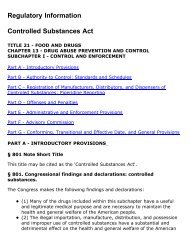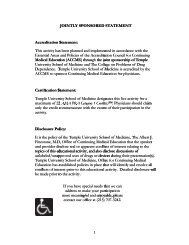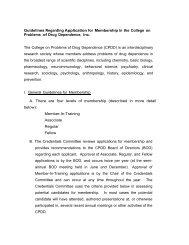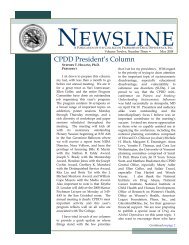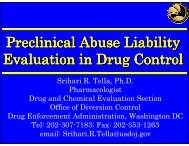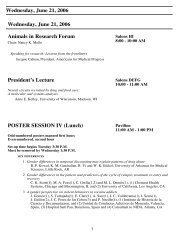CPDD 72nd Annual Meeting • Scottsdale, Arizona - The College on ...
CPDD 72nd Annual Meeting • Scottsdale, Arizona - The College on ...
CPDD 72nd Annual Meeting • Scottsdale, Arizona - The College on ...
Create successful ePaper yourself
Turn your PDF publications into a flip-book with our unique Google optimized e-Paper software.
45<br />
MARIJUANA AND COCAINE USERS DIFFER IN RESPONSES<br />
TO A SOCIAL STRESSOR.<br />
Gillinder Bedi 1,2 , S C Reed 1,2 , S M Evans 1,2 , M Haney 1,2 ; 1 Psychiatry, Columbia<br />
University, New York, NY, 2 Substance Abuse, New York State Psychiatric<br />
Institute, New York, NY<br />
Aims: In human laboratory and clinical studies, an increased neuroendocrine<br />
and behavioral resp<strong>on</strong>se to stress predicts relapse to cocaine use. Although marijuana<br />
treatment is characterized by high rates of relapse, little is known about<br />
resp<strong>on</strong>ses to stress in heavy marijuana smokers. We compared resp<strong>on</strong>se to a social<br />
stressor in primary marijuana and primary cocaine users volunteering for human<br />
laboratory research.<br />
Methods: N<strong>on</strong>-treatment-seeking male cocaine (N=12) and marijuana (N=13)<br />
users completed the Trier Social Stress Task (TSST), a standardized laboratory<br />
stressor involving both a public speaking and a mental arithmetic task c<strong>on</strong>ducted<br />
before an evaluative, unresp<strong>on</strong>sive audience. Cocaine users smoked cocaine<br />
3.8 (±1.5) days/week. Marijuana users smoked cannabis 6.8 (±0.6) days/week.<br />
All had g<strong>on</strong>e at least several hours without drug prior to the TSST. Outcome<br />
measures were heart rate and subjective anxiety, measured with the State-Trait<br />
Anxiety Inventory and the Perceived Stress Scale. Salivary cortisol was also collected<br />
but data are not yet available. Data collecti<strong>on</strong> is <strong>on</strong>going and the final data<br />
set will include n<strong>on</strong>-drug using c<strong>on</strong>trols. Mixed model ANOVAs followed by ttests<br />
assessed for between group differences.<br />
Results: <str<strong>on</strong>g>The</str<strong>on</strong>g> TSST increased heart rate and subjective anxiety in both groups.<br />
<str<strong>on</strong>g>The</str<strong>on</strong>g>re was an interacti<strong>on</strong> between group and time (during vs after TSST) <strong>on</strong><br />
heart rate change from baseline (F(3, 57) = 2.8, p < 0.05), such that marijuana<br />
users had marginally higher heart rate resp<strong>on</strong>ses during the stressor than did<br />
cocaine users (t(19) = 1.8, p < 0.09). <str<strong>on</strong>g>The</str<strong>on</strong>g>re was no effect of group <strong>on</strong> subjective<br />
resp<strong>on</strong>ses to the stressor.<br />
C<strong>on</strong>clusi<strong>on</strong>s: <str<strong>on</strong>g>The</str<strong>on</strong>g>se data suggest that male marijuana smokers have heightened<br />
aut<strong>on</strong>omic stress resp<strong>on</strong>ding relative to male cocaine users. <str<strong>on</strong>g>The</str<strong>on</strong>g>se findings may<br />
have implicati<strong>on</strong>s for development of targeted treatments for marijuana and<br />
cocaine users.<br />
Financial Support: DA19239, DA009236<br />
47<br />
FUNCTIONAL INTERACTION BETWEEN SDF-1ALPHA IN<br />
THE BRAIN AND OPIOID MEDICATIONS.<br />
Khalid Benamar, A Cowan, E B Geller, M W Adler; CSAR, Temple University,<br />
School of medicine, Philadelphia, PA<br />
Aims: Buprenorphine was approved by the FDA in 2002 for use in supervised<br />
withdrawal and maintenance treatment of opioid dependence. Compared to<br />
methad<strong>on</strong>e, it is the most comm<strong>on</strong> clinically used opioid medicati<strong>on</strong> for pain<br />
and opioid dependence management. Buprenorphine is a partial mu-opioid ag<strong>on</strong>ist,<br />
a powerful analgesic in both rodents and humans, has a very l<strong>on</strong>g-lasting<br />
efficacy, high safety profile and does not posses immunosuppressive properties.<br />
<str<strong>on</strong>g>The</str<strong>on</strong>g> purpose of the present study was to test which of the two opioid medicati<strong>on</strong>s,<br />
buprenorphine and methad<strong>on</strong>e, is the more effective analgesic in the presence<br />
of high levels of the chemokine SDF-1 alpha (a c<strong>on</strong>diti<strong>on</strong> that occurs with<br />
neuroinflammatory diseases, including HIV encephalitis).<br />
Methods: Young adult male Sprague-Dawley rats weighing 200-250 g were<br />
used, 8-10 rats per group. A sterilized stainless steel C313G cannula guide (22<br />
gauge, Plastics One Inc., Roanoke) was implanted into the periaqueductal grey<br />
(PAG). <str<strong>on</strong>g>The</str<strong>on</strong>g> latency to flick the tail in cold water (CWT) was used as the<br />
antinociceptive index, according to a standard procedure in our laboratory<br />
(Pizziketti et al., 1985).<br />
Results: <str<strong>on</strong>g>The</str<strong>on</strong>g> dose of 1 mg/kg of buprenorphine subcutaneously (s.c.) produced<br />
a marked antinocicepti<strong>on</strong> in the cold-water tail-flick (CWT) test, reaching a<br />
peak level (89 ± 10% MPA) at 45 min. Similarly, methad<strong>on</strong>e also produced a<br />
marked antinocicepti<strong>on</strong> (100%). Although the maximum % MPA increase was<br />
not significantly different, the dose of methad<strong>on</strong>e was 3 times higher than that<br />
of buprenorphine. Either vehicle (aCSF) or SDF-1alpha was microinjected into<br />
the PAG before buprenorphine or methad<strong>on</strong>e. Pretreatment with SDF-1alpha<br />
failed to alter the analgesic effect of buprenorphine, while it was able to diminish<br />
significantly methad<strong>on</strong>e-induced antinocicepti<strong>on</strong>.<br />
C<strong>on</strong>clusi<strong>on</strong>s: 1) SDF-1alpha in the brain differentially interferes with the opioid<br />
medicati<strong>on</strong>s.<br />
2) Buprenorphine is a more effective analgesic in the presence of high levels of<br />
SDF-1 alpha compared to methad<strong>on</strong>e.<br />
Financial Support: This work was supported by the Nati<strong>on</strong>al Institute of drug<br />
Abuse 06650 and DA 13429].<br />
<str<strong>on</strong>g>CPDD</str<strong>on</strong>g> <str<strong>on</strong>g>72nd</str<strong>on</strong>g> <str<strong>on</strong>g>Annual</str<strong>on</strong>g> <str<strong>on</strong>g>Meeting</str<strong>on</strong>g> <str<strong>on</strong>g>•</str<strong>on</strong>g> <str<strong>on</strong>g>Scottsdale</str<strong>on</strong>g>, <str<strong>on</strong>g>Ariz<strong>on</strong>a</str<strong>on</strong>g><br />
12<br />
46<br />
EXAMINING THE DIFFERENCES IN THE PROGRESSION<br />
TO NICOTINE DEPENDENCE BY GENDER AND<br />
ETHNICITY IN THE U.S. POPULATION.<br />
Roxanne Beharie 1 , F A Wagner 1 , D C Browne 2 , C L Storr 3 ; 1 Morgan State<br />
University, Baltimore, MD, 2 Norfolk State University, Norfolk, VA, 3 University<br />
of Maryland, <str<strong>on</strong>g>College</str<strong>on</strong>g> Park, MD<br />
Aims: Females have significantly higher rates of nicotine dependence than males.<br />
Also, African Americans suffer higher incidence of smoking-related health problems<br />
than Whites. Research has shown racial/ethnic differences in the process of<br />
becoming nicotine dependent, with African Americans being more likely to<br />
become nicotine dependent than Whites. <str<strong>on</strong>g>The</str<strong>on</strong>g> aim of this study was to examine<br />
the progressi<strong>on</strong> to nicotine dependence focusing <strong>on</strong> race/ethnicity group and<br />
gender differences.<br />
Methods: Data from Wave I of the Nati<strong>on</strong>al Epidemiologic Survey <strong>on</strong> Alcohol<br />
and Related C<strong>on</strong>diti<strong>on</strong>s (NESARC) were used for this study (N=14,225).<br />
Nicotine dependence was operati<strong>on</strong>ally defined using DSM-IV criteria in the<br />
NESARC. <str<strong>on</strong>g>The</str<strong>on</strong>g> main independent variables for this analyses included race, gender,<br />
age at first nicotine use, and socioec<strong>on</strong>omic status (SES). Discrete time survival<br />
analyses and c<strong>on</strong>diti<strong>on</strong>al logistic regressi<strong>on</strong> analyses were c<strong>on</strong>ducted using<br />
STATA versi<strong>on</strong> 10.0.<br />
Results: Multivariate survival analyses showed African Americans had 20%<br />
lower odds of becoming nicotine dependent than Whites (aHR=0.80; 95%<br />
CI=0.74-0.88; p< 0.001), adjusting for covariates Of note, females had 15%<br />
lower odds of becoming nicotine dependent than males (aHR=0.85; 95%<br />
CI=0.80-0.91; p



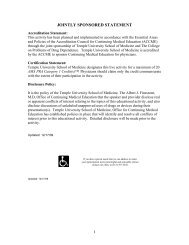
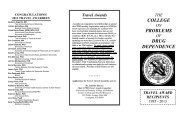
![2013SYMP AND WORKSHOP LIST[web]](https://img.yumpu.com/35325424/1/190x245/2013symp-and-workshop-listweb.jpg?quality=85)
